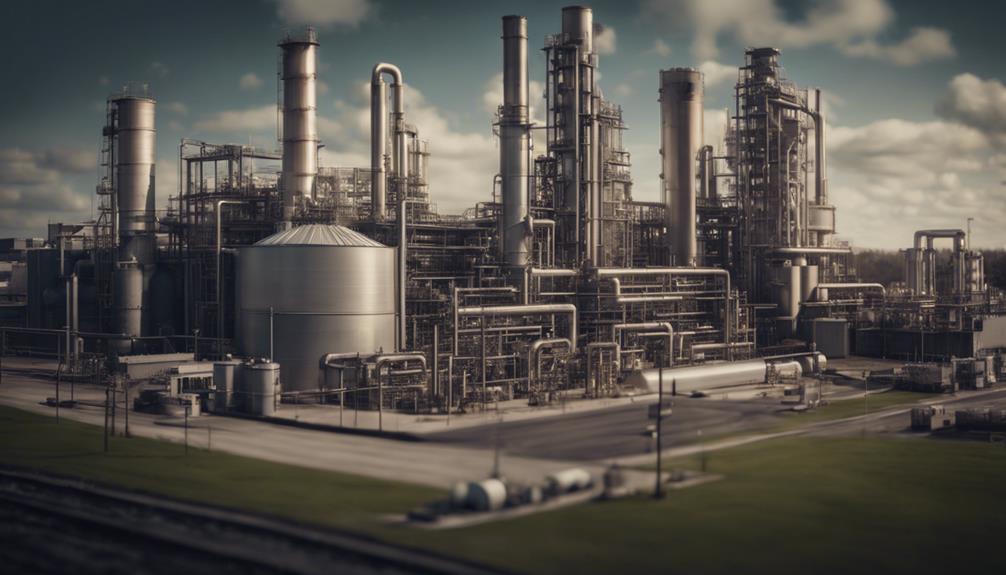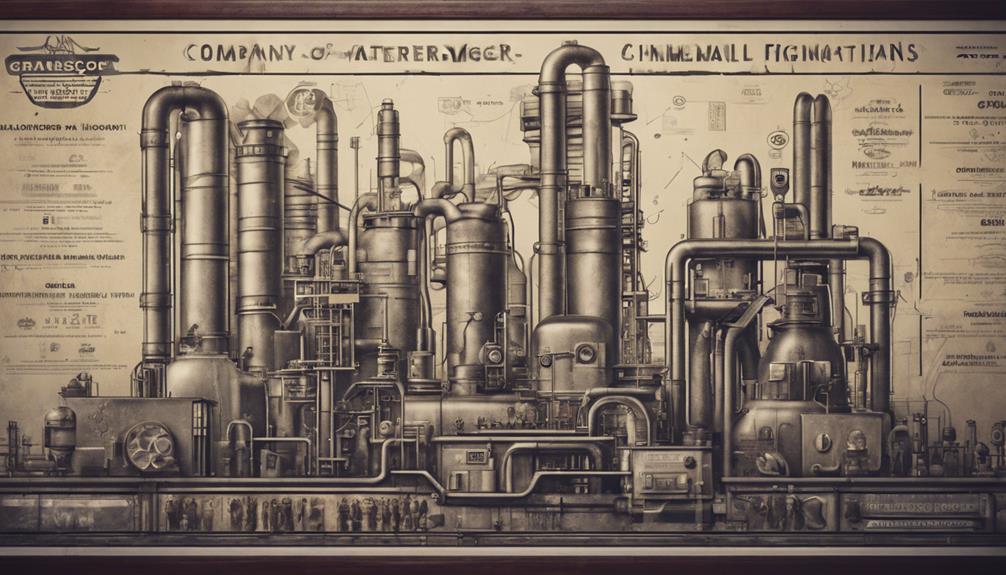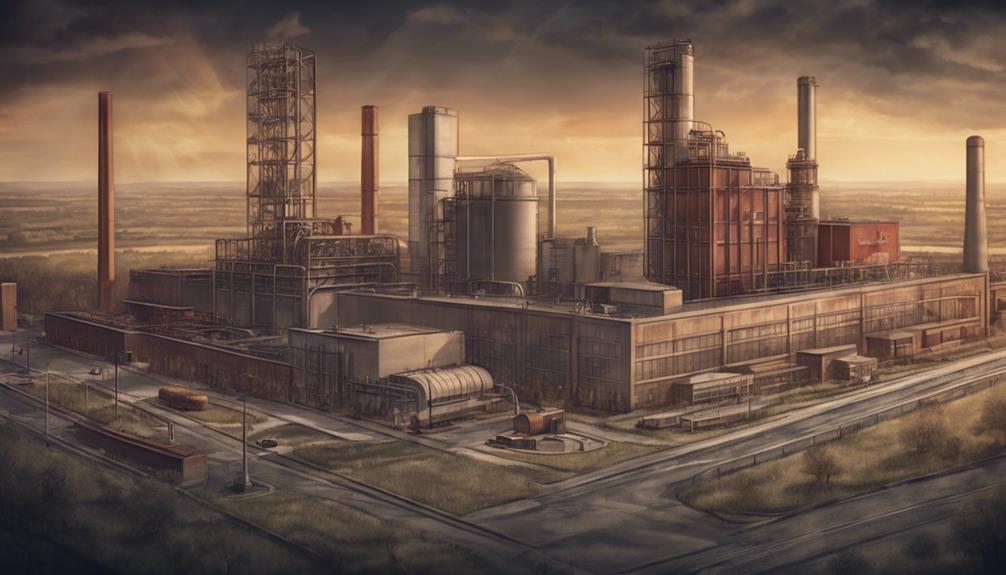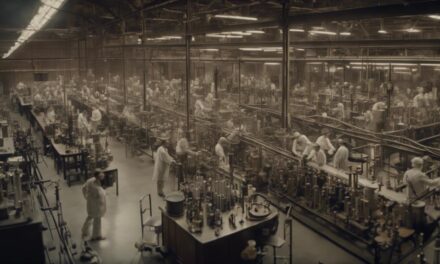Imagine tracing the roots of an industrial giant back to a single chemist's vision—Midland Dow Chemical, founded by Herbert H. Dow in 1897, offers just that story. As you explore the company's early years, you'll find groundbreaking innovations in bromine extraction that set the stage for its expansive growth. But that's just the beginning. From war-time contributions to maneuvering environmental controversies, Midland Dow's journey is filled with strategic moves and major acquisitions, like that of Rohm & Haas Co. Ready to uncover how these elements shaped a global powerhouse?
Key Takeaways
- Founded in 1897 by Herbert H. Dow in Midland, Michigan, and merged with Midland Chemical Company in 1900.
- Pioneered efficient bromine extraction processes and expanded its chemical portfolio rapidly.
- Contributed significantly to war efforts during World War I by producing essential materials like magnesium.
- Faced environmental and legal controversies, including Agent Orange and silicone breast implants lawsuits.
- Merged with DuPont in 2015 to form DowDuPont, enhancing competitiveness and market reach.
Founding and Early Years

Founded in 1897 by chemist Herbert H. Dow in Midland, Michigan, Midland Dow Chemical quickly became a pioneering force in the chemical industry. Herbert's innovative spirit and keen scientific acumen laid the foundation for what would become a major player in the global chemical sector.
Initially, the company focused on producing essential chemicals like bleach and potassium bromide, which were in high demand during that era.
Herbert's vision didn't stop at just one company. By 1900, the Midland Chemical Company, which he initially established, merged with another one of his ventures, the Dow Process Company. This merger was a strategic move that consolidated resources, knowledge, and capabilities, allowing the newly formed Midland Dow Chemical to expand its range of chemical products and improve production efficiency.
This merger not only solidified the company's position in the market but also demonstrated Herbert's forward-thinking approach to business and technology.
During its early years, the company's focus on innovation was evident. The Dow Process Company had already been known for its electrolytic methods to extract bromine from brine, a technique that was revolutionary at the time. By integrating this with the Midland Chemical Company's production capabilities, the company could scale its operations and diversify its chemical portfolio.
Through Herbert's leadership and innovative strategies, Midland Dow Chemical laid a robust groundwork that would enable it to become a global leader. The company's early success in the chemical industry wasn't just a result of business acumen but also of a relentless pursuit of scientific excellence and innovation.
Bromine Production
Building on its early innovations and strategic mergers, Midland Dow Chemical's groundbreaking work in bromine production became the cornerstone of its initial success and rapid diversification. Founded in 1897 by Herbert H. Dow in Midland, Michigan, The Dow Chemical Company initially focused on the extraction and production of bromine, an essential element in many chemical compounds. Dow's early mastery of bromine extraction set it apart from competitors and laid the foundation for a diversified product line.
You'd find that bromine production wasn't just a minor operation for Dow; it was the nucleus of their early business strategy. Dow's innovative chemical processes revolutionized bromine extraction, making it more efficient and cost-effective. This expertise not only led to the production of crucial early products like bleach and potassium bromide but also facilitated the rapid expansion of Dow's chemical portfolio. Their ability to scale bromine production enabled them to venture into the manufacture of other chemicals and materials, positioning the company as a global leader in the chemical industry.
Dow's focus on bromine also spurred technological advancements. The company's early success in this area allowed them to invest in research and development, leading to the creation of new applications and products.
Diversification Efforts

You'll see how Midland Dow Chemical's diversification efforts rapidly expanded its product lines and solidified its market position.
By strategically acquiring key companies and introducing innovative products like plastic resins in the 1930s, the company guaranteed its relevance across various industries.
These moves weren't just about expansion but also about establishing a legacy of adaptability and strategic foresight.
Expanding Product Lines
How did Dow Chemical manage to diversify its product lines so rapidly and effectively within just 20 years of its inception in 1897? The company's success in product line diversification can be attributed to its proactive approach and innovative spirit.
Early on, Dow Chemical recognized the importance of expanding beyond its initial offerings. By the 1930s, the introduction of plastic resins marked a significant milestone, demonstrating the company's commitment to staying ahead of market trends.
During World War I, Dow Chemical's production of war materials, including magnesium, was vital. This not only solidified its reputation but also showcased its ability to pivot and meet urgent needs. Diversification didn't stop there; the company expanded into producing bleach, potassium bromide, and other essential chemicals.
This dynamic approach allowed Dow Chemical to continuously adapt and thrive in a rapidly changing industrial landscape. Their focus wasn't just on meeting immediate demands but also on foreseeing future market needs.
Strategic Acquisitions
Strategic acquisitions have played a pivotal role in Dow Chemical's diversification efforts, greatly bolstering its market presence and research capabilities. By acquiring companies like Rohm & Haas Co. in 2008 for $15.4 billion, Dow Chemical substantially expanded its product portfolio and enhanced its capabilities in specialty chemicals. This move not only diversified its offerings but also positioned the company more robustly in the market.
Dow's strategic acquisitions have included:
- Rohm & Haas Co.: This $15.4 billion acquisition was instrumental in expanding Dow's specialty chemicals.
- K-Dow Joint Venture: Partnering with Petrochemical Industries Co. (PIC) in a venture valued at $9.5 billion, Dow diversified its operations further.
- Strengthened Market Position: These acquisitions helped Dow Chemical cement its standing in new industries.
- Enhanced R&D Capabilities: Mergers and acquisitions have been key in evolving and expanding Dow's research and development.
These strategic moves have enabled Dow Chemical to stay ahead in a competitive landscape, leveraging acquired technologies and expertise to innovate and maintain a competitive edge.
War-Time Contributions
You should examine how Dow Chemical's synthetic rubber production during World War II addressed critical shortages and boosted the Allied war effort.
Additionally, the company's explosives development efforts provided essential materials for military operations.
These contributions illustrate the pivotal role Dow played in supporting wartime logistics and strategy.
Synthetic Rubber Production
During World War II, Dow Chemical in Midland played a pivotal role in the war effort by producing synthetic rubber, a critical material for military vehicles, aircraft, and equipment. The demand for natural rubber far exceeded supply, and Dow's innovative approach to synthetic rubber production became indispensable. This synthetic rubber wasn't just a substitute but a necessity to keep the war machinery operational.
Dow Chemical's synthetic rubber production had several notable aspects:
- Innovative Approach: Dow employed cutting-edge techniques to efficiently produce synthetic rubber, ensuring a steady supply during wartime shortages.
- Support for Military Vehicles: The synthetic rubber was used extensively in tires, gaskets, and other essential components for military vehicles, enhancing their reliability and performance.
- Aircraft and Equipment: Beyond vehicles, synthetic rubber found applications in aircraft and various military equipment, proving its versatility and importance.
- Adaptability: Dow demonstrated remarkable versatility by shifting its production focus to meet critical national needs, showcasing its ability to adapt under pressure.
This strategic contribution of synthetic rubber underscored Dow Chemical's commitment to the war efforts and highlighted its capacity to innovate swiftly and effectively. By meeting these urgent demands, Dow played a significant role in ensuring the Allies' operational success.
Explosives Development Efforts
Throughout World War I, Dow Chemical made significant contributions to the war effort by developing and supplying critical explosives and war materials. The company's development efforts focused on creating effective military solutions, including the production of high-demand explosives and other essential materials.
Dow's expertise in chemical manufacturing enabled the rapid production of items like magnesium, which was indispensable for military applications due to its lightweight and flammable properties.
Dow's involvement didn't stop at basic materials; they also manufactured more complex and dangerous substances. Mustard gas, a notorious chemical weapon, and napalm bombs were among the lethal products developed. These materials played a crucial role in the military's strategic operations, demonstrating Dow's capability to meet wartime demands efficiently.
The war catalyzed the expansion of Dow's product line, as the urgent need for varied war materials pushed the company to innovate and diversify its offerings. This period marked a significant chapter in Dow's history, showcasing its ability to support military efforts through the rapid development and supply of critical materials.
The legacy of these wartime contributions underscores Dow's long-standing role in advancing chemical manufacturing for both military and civilian uses.
Environmental Controversies

Facing numerous legal challenges, Dow Chemical's environmental controversies span decades, involving significant issues like the Rocky Flats Plant lawsuit in 1990 and the production of hazardous chemicals such as napalm and Agent Orange during the Vietnam War.
Dow's involvement in manufacturing Agent Orange, a herbicide used to defoliate forests in Vietnam, led to severe environmental contamination and health problems for both soldiers and civilians. Lawsuits were filed against Dow, resulting in a $180 million settlement for exposure victims.
The Rocky Flats Plant, where nuclear weapons components were produced, became another significant point of contention. Allegations of environmental contamination led to a major lawsuit in 1990. Residents living near the plant claimed exposure to radioactive materials, which allegedly caused numerous health and environmental issues. After a protracted legal battle, Dow Chemical reached a $375 million settlement in 2017 to address these environmental concerns.
Dow's production of napalm during the Vietnam War also drew criticism. Napalm, known for its devastating impact on both people and the environment, exacerbated the company's controversial legacy. Environmental activists and legal entities have long scrutinized Dow for its role in these destructive practices.
Here's a quick rundown of Dow Chemical's environmental controversies:
- Agent Orange: Produced during the Vietnam War, leading to extensive lawsuits and a $180 million settlement.
- Rocky Flats Plant: Environmental contamination led to a 1990 lawsuit and a $375 million settlement in 2017.
- Napalm Production: Made during the Vietnam War, raising significant environmental and ethical concerns.
- Legal Battles: Numerous lawsuits over decades have highlighted issues of environmental contamination and corporate responsibility.
These controversies underscore the complex and often troubling history of Dow Chemical's environmental practices.
Global Expansion
Dow Chemical's post-World War II strategy saw the company rapidly expand its global footprint, starting with the establishment of its first overseas subsidiary in Japan in 1952. This move marked the beginning of Dow Chemical's ambitious foray into overseas markets, aiming to leverage post-war economic growth and establish a robust international presence.
By 1971, Dow Chemical's sales had exceeded $2 billion, underscoring the company's rapid growth and success in global expansion. This achievement wasn't just a proof of their aggressive market penetration but also highlighted their strategic flexibility in identifying and capitalizing on burgeoning opportunities in different regions. Dow's expansion wasn't limited to just opening new facilities; it involved a thorough approach that included forming strategic partnerships and joint ventures.
A notable example is Dow Chemical's joint venture with Petrochemical Industries Co. (PIC) to create K-Dow. Valued at $9.5 billion, this partnership significantly enhanced Dow's foothold in the global petrochemical sector, allowing for shared expertise, risk, and resources. Such collaborations were vital in managing the complexities of international markets and adapting to local demands.
In addition to joint ventures, Dow Chemical's global expansion strategy included acquiring companies to diversify its product portfolio and enhance its technological capabilities. For instance, the 2008 acquisition of Rohm & Haas Co. for $15.4 billion allowed Dow to expand into specialty chemicals, a sector with higher margins and growth potential.
Dow Chemical's global expansion strategy wasn't just about increasing its geographic footprint but also about deepening its operational capabilities. Facilities like the Bluewater Energy Park in Barry, South Wales, specializing in specific polymers like Styron A-Tech, exemplify Dow's commitment to innovation and specialized production on a global scale.
Major Mergers

Major mergers have been pivotal in shaping Dow Chemical's trajectory, enhancing its market competitiveness and expanding its technological and product capabilities. Over the years, Dow Chemical has strategically merged and acquired several companies, greatly altering its path and influence in the chemical industry.
One of the earliest and most critical mergers occurred in 1900, when Dow Chemical joined forces with the Midland Chemical Company. This consolidation allowed Dow to expand its production capabilities and streamline operations, setting a strong foundation for future growth. This early merger was instrumental in establishing Dow's presence in the chemical market.
Fast forward to 2009, Dow Chemical acquired Rohm & Haas, a specialty chemical manufacturer. This acquisition was a game changer, significantly broadening Dow's product portfolio and technological expertise. Through this merger, Dow could offer a wider range of specialty chemicals, catering to diverse industries and enhancing its market reach.
In 2015, Dow Chemical took another bold step by merging with DuPont Company, creating DowDuPont. This merger was monumental, combining the strengths of two industry giants. It not only enhanced Dow's market position but also bolstered its research and development capabilities, driving innovation and efficiency.
These mergers allowed Dow Chemical to:
- Strengthen its presence in various industries
- Expand its product offerings
- Enhance research and development capabilities
- Improve market competitiveness
Through these strategic mergers, Dow Chemical has continuously evolved, adapting to market demands and technological advancements. Each merger has played a crucial role in shaping the company's growth, ensuring it remains a dominant player in the chemical industry.
Recent Developments
Recent developments at Dow Chemical illustrate the company's ongoing efforts to navigate complex regulatory landscapes and address past environmental and legal challenges while continuing to bolster its market presence and innovation capabilities. One of the notable hurdles Dow Chemical faced was a $375 million settlement in 2017 related to environmental contamination. This settlement underscores the ongoing consequences of historical industrial practices and the company's commitment to resolving these issues.
In 2015, Dow Chemical merged with DuPont, creating the entity DowDuPont. This merger was a strategic move to expand both companies' market positions and enhance their research capabilities, allowing them to innovate and compete more effectively in the global market. The formation of DowDuPont marked a pivotal moment, as it combined the strengths of both chemical giants, aiming to foster growth and development in various sectors, including agriculture, materials science, and specialty products.
Additionally, Dow Chemical's acquisition of Rohm & Haas in 2009 significantly enriched its product portfolio. This move allowed Dow to diversify its offerings and gain a competitive edge in specialty chemicals. The acquisition was part of a broader strategy to strengthen the company's market position and drive innovation across different product lines.
Despite these growth strategies, Dow Chemical has had to confront its historical controversies. For instance, the company settled a $180 million fund for victims of Agent Orange exposure, a legacy issue from its involvement in producing this chemical during the Vietnam War. Additionally, Dow Corning, a joint venture of Dow Chemical, declared bankruptcy due to lawsuits over silicone breast implants, further illustrating the complex legal and ethical landscape the company navigates.
Frequently Asked Questions
What Is the History of Dow Chemical?
When you look into Dow Chemical's history, you'll see its founding years in 1897 were pivotal. Early expansions included diversifying from bleach to plastics.
Leadership changes over time shaped its direction. Key mergers, like acquiring Union Carbide in 2001, had a substantial impact on its global reach.
Dow's global impact includes both innovative contributions and controversies, highlighting its complex legacy in the chemical industry.
What Is the Dow Chemical Controversy?
You're asking about the Dow Chemical controversy. The company faced significant ethical concerns and legal battles, particularly related to its environmental impact.
Dow produced Agent Orange, leading to legal issues and a $180 million settlement. Public protests erupted over its involvement in napalm production.
Additionally, Dow faced regulatory fines and a $375 million settlement over environmental contamination. These controversies highlight ongoing public and regulatory scrutiny of Dow's practices.
Why Is Dow Chemical in Midland, Mi?
You might say Dow Chemical's roots in Midland, MI are no accident. The company's origins trace back to 1897 when Herbert H. Dow, the founder, recognized the geographic significance of the area.
Midland offered brine for chemical extraction, which was essential for early developments. Over time, Dow Chemical's presence had a profound community impact, making Midland the heart of its operations, research, and development activities.
What Does Dow Chemical Make in Midland, Mi?
At Dow Chemical in Midland, MI, you'll find extensive product lines including chemicals, plastics, and synthetic materials. Their manufacturing processes are cutting-edge, with significant research initiatives driving innovation. They prioritize sustainable practices, ensuring environmentally-friendly production.
Beyond their industrial focus, Dow engages in community outreach, contributing to local development. This combination of advanced manufacturing and community support makes Dow an essential part of Midland's economic and social fabric.


